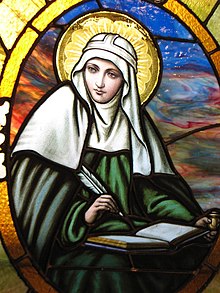Sante
Dalam pengarap Kristian, sante iya nya orang ti dikelala ngembuan tikas pengudus, sebaka, tauka semak enggau Allah Taala ti nyelai. Taja pia, ngena leka jaku orang kudus bepanggai ba konteks enggau denominasi. Dalam ajar Katolik, Ortodoks Timur, Anglikan, Ortodoks Oriental, enggau Lutheran, semua orang ke midang ke tetap ati sida di Serega dianggap sante, tang sekeda dianggap patut dipebasa tauka ditiru enggau lebih agi.[1] Pengiktirafan rasmi eklesiastik diberi ngagai sekeda sante denominasyen nengah proses kanonisasyen dalam Gerija Katolik tauka ngemesaika dalam Gerija Ortodoks Timur pengudah sida dikemendarka.[2][3]

Malin
edit- ↑ Woodward, Kenneth L. (1996). Making Saints. Simon & Sachier. p. 16. ISBN 978-0-684-81530-5.
Among other Christian churches, the Russian Orthodox retains a vigorous devotion to the saints, especially the early church fathers and martyrs. On rare occasions, new names (usually monks or bishops) are grafted onto their traditional list of saints ... Something like the cult continues among Anglicans and Lutherans, who maintain feast days and calendars of saints. But while the Anglicans have no mechanism for recognizing new saints, the Lutherans from time to time do informally recommend new names (Da Hammarskjold, Dietrick Bonhoeffer, and Pope John XXIII are recent additions) for thanksgiving and remembrance by the faithful. The saint, then, is a familiar figure in all world religions. But only the Roman Catholic Church has a formal, continuous, and highly rationalized process for 'making' saints.
- ↑ Bebis, George (n.d.). "The Lives of the Saints". Greek Orthodox Archdiocese of America. Retrieved 7 May 2016.
- ↑ "The Glorification of the Saints in the Orthodox Church". www.oca.org. Retrieved 2024-02-01.